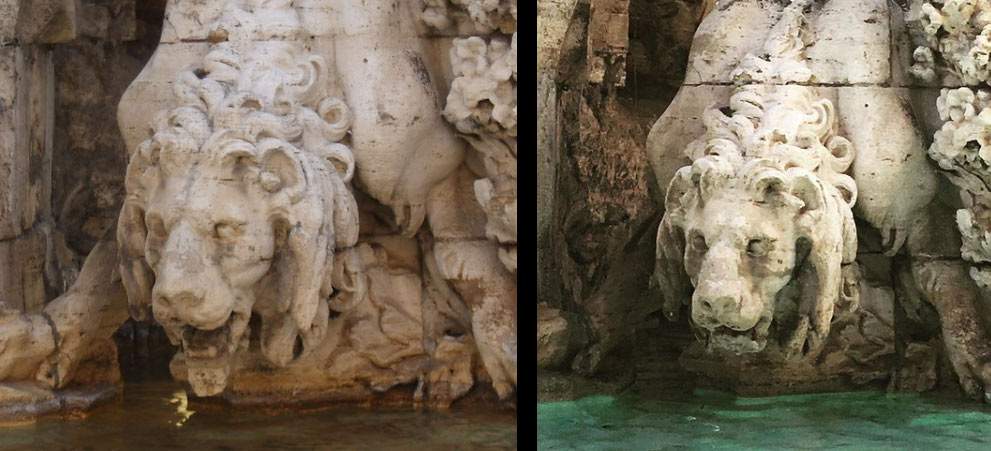The news of the damage to the lion of the Fountain of the Four Rivers, Gian Lorenzo Bernini ’s masterpiece in Rome’s Piazza Navona, is unfortunately very true, and serious are the consequences: the lion has in fact lost its expression, and for five months it has looked disfigured in the eyes of Romans and tourists alike. Fortunately, however, this time the disfigurement was not caused by human action: the Capitoline Superintendence, in fact, clarified that what caused the detachment of the lion’s jawbone was the breaking of a metal anchor pin that had worn out. And the damage occurred last August 18: the fragments were recovered by the Superintendence’s technicians, who arranged them in the laboratory while waiting for the reattachment work, scheduled for January 13, 2021.
The missing fragment, we were confirmed by the Superintendency, is currently presented broken down into three parts. After the appropriate clarifications in recent days, however, many have wondered why the Superintendence never gave notice of the damage, especially since it affects one of Rome’s main masterpieces, as well as an important portion of the lion, so much so that the detachment has disfigured it: “It should be borne in mind,” they let the Capitoline body know in response to this question, “that episodes of this type on historical artifacts exposed to atmospheric agents are not that unusual, deterioration being an inevitable phenomenon. In this case, the damage involved a small part of the sculptural apparatus, and it is technically reversible.”
Why has it been five months from the damage to the re-adhesion surgery? It is basically delays due to the new wave of Covid-19 contagions that started in late summer, which caused the intervention to be delayed until the first quarter of 2021. “The more than 500 fountains in Rome,” say the Superintendency, “are subject to periodic cleaning of the basins and respect areas as well as control and maintenance of the water systems by the Department of Infrastructure Development and Urban Maintenance, which uses specialized firms and ACEA ATO2 for the monumental fountains equipped with recirculation. These activities are carried out dintesa and in collaboration with the Offices of the Capitoline Superintendence, which carry out checks and monitoring of the state of conservation and prepare more in-depth interventions of weeding and washing of the surfaces by specialized restorers, such as the recent interventions on the fountains of the Bocca della Verità, the Giglio at Villa Doria Pamphilj and the small fountains of the Palazzo dei Penitenzieri in Via della Conciliazione (subject to vandalism).”
The Fountain of the Four Rivers was restored in 2006-2008 (the work had been conducted by the Istituto Superiore per la Conservazione e il Restauro in consultation with the Capitoline Superintendent’s Office): so how is it possible, many have asked, that in twelve years wear and tear damage has already occurred? “This is an issue,” the Superintendency let them know, “that in the last restoration, had not emerged. On that occasion, the state of preservation of the lion’s lower jaw was evaluated, but it did not present stability problems. The exposed parts of the pin did not appear corroded, and as a precautionary measure they were treated with oxidation inhibitor anyway. Documentation on previous conservation work from 1975 to 2006-2008 was consulted, but no specific information was found on the pivoting of the detached stone portion.”
Finally, what is the current state of conservation of Bernini’s masterpiece? Meanwhile, it should be specified that the Fountain of the Four Rivers is still monitored: “On the occasion of the emptying of the fountain’s basin for ordinary cleaning operations,” the institution states, “the Superintendence’s technicians carry out monthly close inspections of the sculptures. The monitoring of the upper parts of the cliff takes place during the weed control interventions, which are carried out annually with the use of the aerial platform.” What emerges is that “the fountain currently presents differentiated degradation phenomena, mainly related to the presence of water (biological patina and limestone encrustation).”
Pictured, left: the intact lion (ph. Francesco Bini, photo from 2006), right: the lion without the jaw (ph. @larissaromeguide via Instagram, photo from Dec. 5, 2020)
 |
| On damage to Bernini's lion, Sovrintendenza: "episodes of this kind are not unusual" |
Warning: the translation into English of the original Italian article was created using automatic tools. We undertake to review all articles, but we do not guarantee the total absence of inaccuracies in the translation due to the program. You can find the original by clicking on the ITA button. If you find any mistake,please contact us.